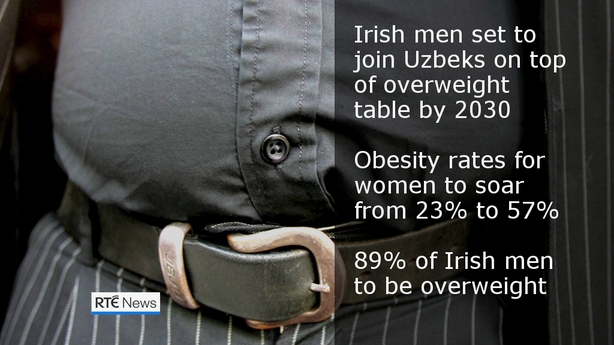Speaking on RTÉ's Morning Ireland, Professor Donal O'Shea said new World
Health Organization figures show that Ireland is on course to be the
fattest country in Europe by 2030.
Prof O'Shea, Head of Weight Management Service in St Columcille's and
St Vincent's hospitals, said this report has to be seen as a tipping
point.
He said the Healthy Ireland 2013-2025 plan is the only way forward
but if action is not taken, it's just another document sitting on a
shelf.

The as-yet unpublished WHO figures suggest Europe is heading for an
unprecedented explosion in rates of obesity and excess weight, with
Ireland the worst-affected.
In 2030, the proportion of obese and overweight men in Ireland is
projected to rise to 89% with a corresponding 85% of women falling into
this category.
The forecast puts Irish men at the top of an "overweight" table of 53 countries, matched only by Uzbekistan.
"Overweight" is clinically defined by a Body Mass Index (a measure
relating to height and weight) of 25 to 29.9, and "obese" by a BMI of 30
and above.
For this study, the "overweight" category also included anyone who was obese.
In terms of obesity alone, the estimates show a big jump for women in Ireland, soaring from 23% to 57%.
The proportion of obese Irish men was expected to increase from 26%
to 48% while the figure for those either overweight or obese rising from
74% to 89%.
While few countries were expected to see stable or decreasing
overweight and obesity rates, the Netherlands appeared to be doing
better than most.
Fewer than half of Dutch men were predicted to be overweight or
obese, and just 8% obese, by 2030 compared with 54% and 10% in 2010.
For Dutch women, overweight and obese rates were due to fall slightly
from 44% to 43% while the level of obesity alone was expected to drop
significantly from 13% to 9%.
Prof O'Shea described the findings as "extremely scary", and "unthinkable" in terms of physical and mental healthcare.
He said they are likely be accurate in Ireland and the UK as these
were the only countries which measured participants, while the other 51
countries used self-reported data.
Prof O'Shea said he believed Ireland was leading the trend because we
have a particular problem with physical activity levels, especially
among young women.
He said there has been a levelling off of childhood obesity rates
overall, because of falling levels in better-off, better-educated
socioeconomic groups.
However, he said in less well educated, less well-off groups, the upward trend is dramatic.
He said 12% of three-year-olds in lower socioeconomic groups are obese compared to 4% in better-off, better-educated groups.
IHF says figures are 'alarming'
The Irish Heart Foundation has described the latest figures on predicted obesity levels in Ireland as truly alarming.
Speaking on RTÉ's News at One, Head of Health Promotion with the
Irish Heart Foundation Maureen Mulvehill said obesity would increase the
levels of heart disease and stroke.
"We're going to see a reversal of the trends we've seen in the last
40 years where heart disease and stroke have reduced in prevalence and
in terms of premature deaths, and we're going to see that reversed.
"We do know that people who are overweight and obese, that heart
disease and diabetes can accompany obesity and people are deprived of up
to eight years of life and up to 19 years of a healthy life."
Ms Mulvehill said that regulation governing the marketing of unhealthy food to children needs to be extended immediately.
She said that there was no standard to guide schools on the type of
food they provide to children and a tax on sugary sweets and drinks
needs to be introduced.
No comments:
Post a Comment